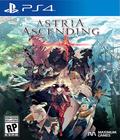Pre-order Astria Ascending
My favorite JRPG era was the PS1 because it had a lot of quirky titles that would probably be considered indie titles these days — including my favorite JRPG of all time, Valkyrie Profile. (It didn't hurt that the console featured blatant classics like Final Fantasy 7.) Astria Ascending is effectively Valkyrie Profile remade as a modern indie title and written by Final Fantasy veteran writer Kazushige Nojima. In other words, it's made to appeal to me as much as possible. Thankfully, based on our time with the preview build, the game will likely please its target audience.
Astria Ascending is set in the peaceful land of Harmonia, which is threatened by monsters called Noises. To stop them, Harmonia has adopted a "The Ones Who Walk Away from Omelas" system. Citizens are called up to become demigods — incredibly powerful fighters gifted with amazing abilities — at a cost. Demigods "ascend" within three years of gaining their powers and either die or become stars, depending on who you ask. The game follows the 333rd generation of demigods who are the equivalent of one day away from retirement as they try to keep their world safe from danger.
The characters in Astria Ascending are a unique bunch. The thief, Arpajo, is an elderly man who is happily married to the summoner, Alasia. The primary wizard is a huge beefy monster-like man named Dagmar. The game generally tends to eschew the stereotypical appearances for characters, so they stand out in ways that are not just "wizard" or "warrior." When you add the fact that each character is fated to die, you get a non-standard group with a number of different perspectives.
Exploration in Astria Ascending feels a whole lot like the old PS1 game, Valkyrie Profile. The game is set on a 2D plane, and you can move around and hop like you're in a platformer. You engage in battle by attacking enemies on the battlefield, and early on, you get a magic ring that lets you stun them in place. There's also some light puzzling; an early puzzle poses a simple riddle that you must complete with some basic platforming to hit switches in a specific order.
At first blush, the turn-based combat system looks straightforward in that players attack, defend, use items, or cast spells with their limited supply of MP. Of course, each character has a unique set of skills and elemental effects. Certain characters are strong or weak to specific elements, and while some characters have access to multiple elemental spells, there's a hierarchy of who is advantageous against which elements.
Combat may appear simple, but it has some complexity that allows you to get the most out of your characters. Players earn focus points (FP) by striking enemy weaknesses or having a character skip a turn in battle to focus. By doing so, you can earn up to four FP. During a character's turn, you can allocate up to four FP to a character, which boosts the power of their next attack by 50 percent.
This lends itself to some interesting combat strategies. Even if a character isn't a heavy hitter, if they can reliably hit an enemy weakness, they can build up focus to allow a non-elemental heavy hitter to smash hard. This encourages players to swap characters around because being able to hit specific elemental weaknesses is often more important. It feels rather like Persona in that way.
Beyond combat and dungeons, players have the usual JRPG fare of side-quests and exploration. Perhaps the most interesting part of this is J-Ster, which is a miniature collectible "card" game you can play with characters around the world. You get J-Ster tokens by completing quests, winning contests, or turning enemies into tokens. It instantly called to mind things like Triple Triad, and I look forward to seeing how deep the J-Ster rabbit hole goes in the final version.
One thing I need to point out is the game's customizable difficulty level. You can adjust many different aspects of the game at any time, à la Bravely Default, including enabling or disabling random encounters, determining if you get EXP/money/items/etc. after a battle, and even if non-active characters gain EXP and how much. This allows you to figure out exactly how powerful you want to get while maintaining modern features, like everyone in the party gaining EXP. Of course, you can also customize the game to be more difficult if it's too easy.
The only real criticism I had from the preview build is more of an acknowledgment of the game's tone. Astria Ascending feels like a modernized version of a quirky JRPG you'd get during the PS1 era. It's very familiar in a lot of ways and aims to recapture a very specific period in the JRPG genre's life cycle. This isn't a bad thing if you're hankering for something more old-school, but be prepared for something nostalgic and familiar.
Overall, I'm really excited about Astria Ascending. The preview build brought back to mind days of popping a weird new game into my PS1 and being engrossed for hours on end. Astria Ascending feels like part Final Fantasy, part Valkyrie Profile, and all JRPG goodness. Hopefully, the final version will live up to expectations when it hits on Sept. 30 for the Nintendo Switch, PC, PlayStation 4 and Xbox One.
More articles about Astria Ascending











 An epic adventure with the charm and pedigree of a classic JRPG, Astria Ascending tells an expansive story of fate, sacrifice and new beginnings.
An epic adventure with the charm and pedigree of a classic JRPG, Astria Ascending tells an expansive story of fate, sacrifice and new beginnings.









